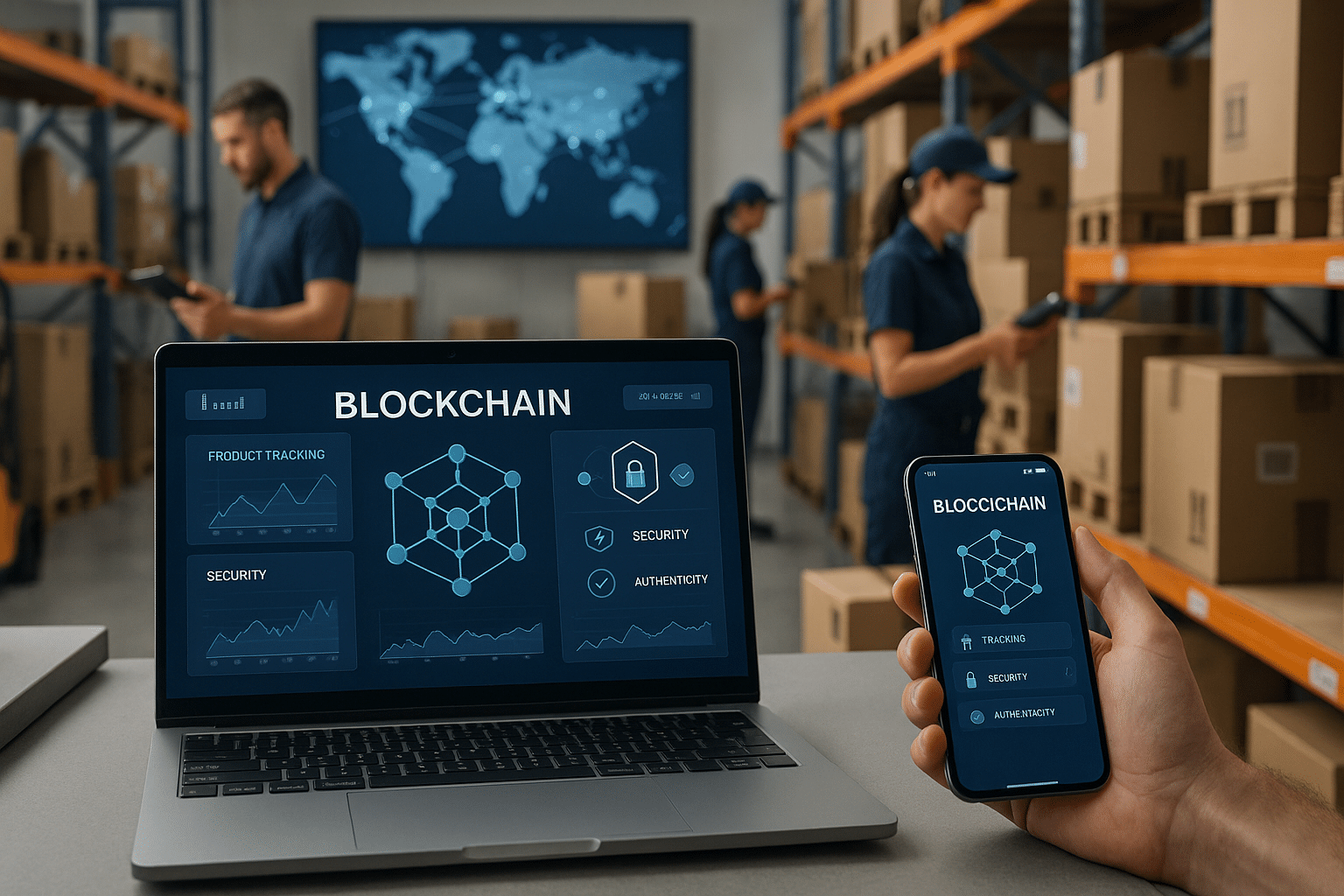The inability to accurately track and trace the journey of a product from manufacture to delivery often results in inefficiencies, fraud, and even endangerment of human lives. But what if we could make this process transparent, secure, and efficient? Enter Blockchain technology, the groundbreaking tool that is revolutionizing supply chain management.😉
Blockchain, best known as the technology behind cryptocurrencies, such as Bitcoin, has gained a reputation for its ability to create decentralized, tamper-resistant ‘ledgers’ of transactions. But it is this technology’s potential in the realm of supply chain management that is increasingly garnering attention. In this blog, we will explore in-depth how Blockchain technology is unlocking a new era of transparency in supply chain management.🔓
But before we delve into the nitty-gritty, let’s take a moment to understand what we mean by ‘transparency’ in the context of supply chain management. Transparency refers to the ability to track a product’s journey through every stage of the supply chain. From the raw materials to the finished product, transparency allows us to understand the ‘who’, ‘what’, ‘where’, ‘when’, and ‘how’ of a product’s journey. And it is in this area that Blockchain truly shines.⭐
Blockchain: The Game-Changer for Supply Chain Management
Imagine a world where every transaction, every movement of goods, every contractual agreement, and every communication within a supply chain is recorded in an immutable, transparent digital ledger. That’s the world that Blockchain technology can create. But how does it do this? Let’s break it down.🔨
Blockchain technology functions as a decentralized, digital ledger. This ledger records transactions across many computers so that any involved record cannot be altered retroactively, without the alteration of all subsequent blocks. This makes the technology perfect for recording events, medical records, identity management, transaction processing, and documenting the provenance of goods. The inherent transparency and security of Blockchain make it an ideal tool for managing and recording transactions in a supply chain.🔗
A Sneak Peek into The Journey Ahead
In the subsequent sections of this blog, we will delve into the specific ways in which Blockchain is revolutionizing supply chain management. We will explore real-life examples of companies using Blockchain to gain a competitive edge, and we will also examine the challenges that companies face in implementing this technology.🚀
We will look at how Blockchain is helping to combat fraud, increase efficiency, improve traceability, and build trust within the supply chain. And we will not shy away from discussing the challenges and potential pitfalls of implementing Blockchain technology.💡
Get ready to embark on an intriguing journey into the world of Blockchain and supply chain management, where transparency, security, and efficiency are more than just buzzwords – they are the foundations of a new era in global commerce. Buckle up, and let’s dive in!🌐
Unlocking Transparency: Blockchain’s Revolutionary Impact on Supply Chain Management
Blockchain technology has steadily been gaining recognition outside its original arena of digital currency. One sector where this technology is beginning to show immense potential is in supply chain management. But how exactly is blockchain revolutionizing this industry? What are the benefits, challenges, and practical implications of adopting this technology?
In this article, we will delve deep into these questions, providing you with a comprehensive understanding of how blockchain is transforming supply chain management. We will examine case studies, understand the technology’s advantages and drawbacks, and explore its future prospects.
Understanding Blockchain and Its Application in Supply Chain Management
Blockchain is essentially a decentralized digital ledger that records transactions across multiple computers. This technology ensures transparency, security, and permanence of data, as no single entity can alter the information once it’s been recorded.
In the context of supply chain management, blockchain can be a game-changer. It can ensure that every transaction, right from the production of goods to their final delivery, is recorded and visible to all parties involved. This level of transparency can significantly reduce fraud, streamline operations, and enhance customer trust.
Blockchain’s Role in Streamlining Supply Chain Processes
Typically, supply chains involve multiple stakeholders, including manufacturers, distributors, retailers, and customers. Each of these parties often operates in silos, leading to a lack of transparency and inefficiency. Blockchain technology can break these silos, creating a unified, transparent, and efficient system.
For instance, consider the process of shipping a product from a manufacturer to a retailer. Traditionally, this process involves numerous paperwork, delays, and opportunities for fraud. With blockchain, all relevant information can be digitized and made available in real-time to all parties, significantly improving efficiency and reducing the chances of fraud.
Video Reference: “How Blockchain Will Radically Transform the Economy” by Bettina Warburg, TED Talks.
Case Study: Blockchain in Action
Many companies have begun to explore the benefits of blockchain in supply chain management. An excellent example of this is the global shipping company, Maersk.
In partnership with IBM, Maersk developed a blockchain platform called TradeLens. This platform digitizes and streamlines the shipping process, enabling real-time access to shipping documents and automating administrative tasks. As a result, Maersk has reported increased transparency, reduced costs, and improved efficiency.
Other notable examples include Walmart, which is using blockchain to track the origin of food products, and De Beers, which uses the technology to eliminate conflict diamonds from its supply chain.
Challenges of Implementing Blockchain in Supply Chain
Despite the potential benefits, implementing blockchain in supply chain management is not without challenges. Firstly, the technology is still relatively new, and many companies lack the necessary knowledge and expertise to implement it effectively.
Secondly, integrating blockchain into existing systems can be a complex and time-consuming process. This is particularly true for large companies with established supply chains. Additionally, regulatory hurdles can pose challenges, as blockchain is a global technology that often operates across national borders.
Lastly, like any technology, blockchain is not immune to security threats. Although it is inherently secure, vulnerabilities can occur in the application layer, potentially exposing sensitive data.
Looking Ahead: The Future of Blockchain in Supply Chain Management
The future of blockchain in supply chain management looks promising. As the technology matures and companies become more comfortable with its use, we can expect to see more widespread adoption.
Moreover, advancements in related technologies such as Internet of Things (IoT) and artificial intelligence (AI) will likely enhance the capabilities of blockchain, opening up new possibilities for supply chain management.
Table: Blockchain Adoption in Supply Chain Management
| Company | Use of Blockchain | Results |
|---|---|---|
| Maersk | TradeLens platform for shipping | Increased transparency, reduced costs, improved efficiency |
| Walmart | Tracking origin of food products | Enhanced food safety, improved traceability |
| De Beers | Eliminating conflict diamonds | Increased transparency, enhanced customer trust |
In conclusion, while blockchain holds immense potential for revolutionizing supply chain management, it is not a silver bullet. Companies need to carefully consider the implications of implementing this technology, including the potential challenges and risks. With the right approach and understanding, blockchain can indeed unlock a new level of transparency and efficiency in supply chain management.
Explore Blockchain’s Potential
To delve deeper into the potential of blockchain in supply chain management, I recommend the following resources:
- Book: “Blockchain: Blueprint for a New Economy” by Melanie Swan
- Course: “Blockchain Basics” on Coursera
Also, don’t forget to watch the video “How Blockchain Will Radically Transform the Economy” by Bettina Warburg on TED Talks.

Conclusion
In wrapping up this extensive exploration of advanced IT and engineering concepts, it is crucial to revisit the salient points that have been elaborated throughout the discourse. We started by demystifying the complex universe of software engineering, detailing the different paradigms and methodologies involved in developing robust and efficient software systems. Key areas such as agile development, DevOps, and microservices were touched upon, offering readers a panoramic view of today’s software engineering landscape.
Moving on, we delved into the heart of Information Technology (IT), investigating its various subsets and their implications for modern businesses. We highlighted the transformative role of IT in driving innovation, enhancing efficiency, and fostering a competitive edge in the digital economy. Moreover, the pivotal importance of data security in the IT sphere was underscored, illuminating the necessity for effective cybersecurity strategies to protect sensitive information.
From there, we charted the trajectory of engineering innovations, elucidating on the mechanics behind technologies that are reshaping our world. This included the burgeoning field of AI, the power of automation, and the future potential of quantum computing.
Looking back, it’s clear that understanding these advanced technical concepts is not just a matter of intellectual curiosity, but a necessity in today’s rapidly evolving technological climate. The ability to comprehend and apply these principles can significantly enhance our capacity to innovate and solve problems in our professional and personal lives.
In conclusion, the transformative potential of technology, when harnessed correctly, is virtually limitless. It can drive economic growth, improve societal wellbeing, and even tackle some of our world’s most pressing challenges. However, to truly unlock this potential, we must be willing to continually learn, adapt, and innovate. I encourage you to reflect on the insights gleaned from this article, share your thoughts in the comments section, and discuss these concepts with your peers. You can delve deeper into these topics through resources like IBM, Microsoft Research, and ACM.
In the ever-evolving world of technology, there is always more to learn. So let’s continue this journey together, exploring, understanding, and shaping the future of IT and engineering. Remember, every step we take towards increasing our technical acumen, no matter how small, can make a significant impact. 🚀🌐💻
Reference(s): IBM (n.d.). IT Infrastructure | IBM. Retrieved from https://www.ibm.com/topics/it-infrastructure
Microsoft Research (n.d.). Software Engineering – Microsoft Research. Retrieved from https://www.microsoft.com/en-us/research/topic/software-engineering/
ACM (n.d.). Welcome — Association for Computing Machinery. Retrieved from https://www.acm.org/
Tags: [software engineering] [information technology] [AI] [data security] [innovation]



